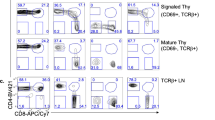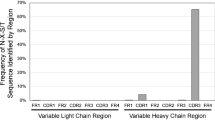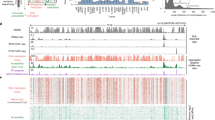Abstract
The intron separating the variable- and constant-region exons of the rearranged immunoglobulin heavy-chain locus contains a lymphocyte-specific transcriptional enhancer1,2. The enhancer is a member of a class of cis-acting, tissue-specific, transcriptional control elements which are characterized by orientation-independent and relatively position-independent function1,2. In vivo analysis of the position of DNA-binding factors, by assessing the availability of specific bases to chemical modification, has identified four sequence clusters within the heavy-chain enhancer, denoted El to E4 (refs 3, 4). These sites are protected (that is, occupied) only in B lymphocytes. A consensus sequence relationship (consensus CAGGTGGC) between these four sites was suggested where three of the sites conformed to the consensus in seven of eight positions while the other was homolgous in six of eight positions. We proposed that a single trans-acting factor might recognize all four sites3,4. Using an assay involving gel electro-phoresis of DNA–protein complexes5–8 to detect sequence-specific DNA binding factors that recognize these related motifs, we have now identified a mouse B-cell nuclear factor (NF-μE1) which binds specifically to one such motif within the mouse heavy-chain gene enhancer. This factor binds poorly, if at all, to the other related motifs, and other factors have been identified which interact preferentially with some of these latter motifs. Dimethyl sulphate interference experiments suggest that the NF-μE1 factor is in contact with at least the guanine residues in the seqeunce GATGGCCGATC. This factor seems to be present in both lym-phoid and non-lymphoid cell lines.
This is a preview of subscription content, access via your institution
Access options
Subscribe to this journal
Receive 51 print issues and online access
$199.00 per year
only $3.90 per issue
Buy this article
- Purchase on SpringerLink
- Instant access to full article PDF
Prices may be subject to local taxes which are calculated during checkout
Similar content being viewed by others
References
Banerji, T., Olson, L. & Schaffner, W. Cell 33, 729–740 (1983).
Gillies, S. D., Morrison, S. L., Oi, V. T. & Tonegawa, S. Cell 33, 717–728 (1983).
Ephrussi, A., Church, G. M., Tonegawa, S. & Gilbert, W. Science 227, 134–140 (1985).
Church, G. M., Ephrussi, A., Gilbert, W. & Tonegawa, S. Nature 313, 798–801 (1985).
Fried, M. & Crothers, D. M. Nucleic Acids Res. 9, 6505–6525 (1981).
Garner, M. M. & Rezvin, A. Nucleic Acids Res. 9, 3047–3060 (1981).
Carthew, R. W., Chodosh, L. A. & Sharp, P. A. Cell 43, 439–448 (1985).
Singh, H., Sen, R., Baltimore, D. & Sharp, P. A. Nature 319, 154–158 (1986).
Sen, R. & Baltimore, D. Cell (in the press).
Hayday, A. C. et al. Nature 307, 334–340 (1984).
Sienbenlist, U. & Gilbert, W. Proc. natn. Acad. Sci. U.S.A. 77, 122–126 (1980).
Maxam, A. & Gilbert, W. Meth. Enzym. 65, 499–525 (1980).
Grosschedl, R., Constantini, F. & Baltimore, D. Banbury Rep. 20, 187–196 (1985).
Dignam, J. D., Lebovitz, R. M. & Roder, R. G. Nucleic Acids Res. 11, 1475–1489 (1983).
Palcios, R. & Steinmetz, M. Cell 41, 727–734 (1985).
Author information
Authors and Affiliations
Rights and permissions
About this article
Cite this article
Weinberger, J., Baltimore, D. & Sharp, P. Distinct factors bind to apparently homolgous sequences in the immunoglobulin heavy-chain enhancer. Nature 322, 846–848 (1986). https://doi.org/10.1038/322846a0
Received:
Accepted:
Issue date:
DOI: https://doi.org/10.1038/322846a0
This article is cited by
-
Human HE2 (?B) and ?A motifs show the same function as whole IgH intronic enhancer in transgenic mice
Molecular and Cellular Biochemistry (1994)
-
Characterization of nucleotide sequences that interact with a nuclear protein fraction in rRNA gene of Vicia faba
Plant Molecular Biology (1992)
-
Blockage to exonuclease III digestion in the chromatin of Saccharomyces cerevisiae maps to the in vitro ? determined binding site of a trans-acting regulatory factor
Current Genetics (1990)
-
Functional cooperativity between protein molecules bound at two distinct sequence elements of the immunoglobulin heavy-chain promoter
Nature (1989)



